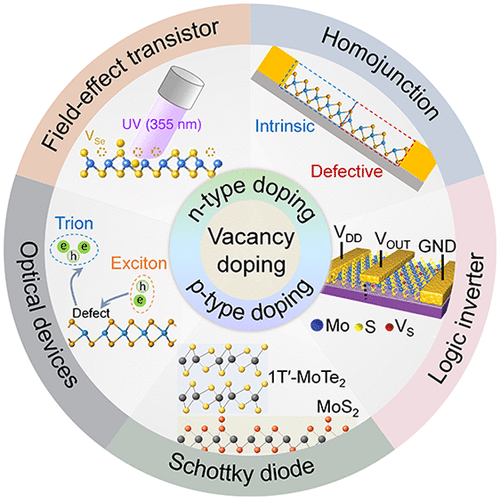当前位置:
X-MOL 学术
›
Acc. Mater. Res.
›
论文详情
Our official English website, www.x-mol.net, welcomes your
feedback! (Note: you will need to create a separate account there.)
Single-Atom Vacancy Doping in Two-Dimensional Transition Metal Dichalcogenides
Accounts of Materials Research ( IF 14.0 ) Pub Date : 2021-07-20 , DOI: 10.1021/accountsmr.1c00097 Xiankun Zhang 1, 2 , Li Gao 1, 2 , Huihui Yu 1, 2 , Qingliang Liao 1, 2 , Zhuo Kang 1, 2 , Zheng Zhang 1, 2, 3 , Yue Zhang 1, 2, 3
Accounts of Materials Research ( IF 14.0 ) Pub Date : 2021-07-20 , DOI: 10.1021/accountsmr.1c00097 Xiankun Zhang 1, 2 , Li Gao 1, 2 , Huihui Yu 1, 2 , Qingliang Liao 1, 2 , Zhuo Kang 1, 2 , Zheng Zhang 1, 2, 3 , Yue Zhang 1, 2, 3
Affiliation

|
Faced with the growing quests of higher-performance chips, developing new channel semiconductors immune to short channel effects has become a realistic option for continuing Moore’s Law. With outstanding gate electrostatic capacitance, stable chemical properties, and suitable bandgap, two-dimensional (2D) transition metal dichalcogenides (TMDCs) are considered as potential candidates for next-generation channel materials. However, the practical applications of 2D TMDCs are severely limited by stable, precise, and controllable doping technologies, due to their ultrathin body and dangling bond-free surface. Compared to three-dimensional semiconductors, donors in 2D semiconductors need larger ionization energy which can be attributed to the reduced screening of Coulomb interaction and the larger bandgap induced by quantum confinement. Limited by the ultrathin body of 2D TMDCs and the strong film–substrate charge transfer, typical silicon-based substitutional doping technology encounters some headache difficulties in 2D TMDCs and hardly achieves high-concentration doping. The other two doping technologies also cannot take on this task either; local gate electrostatic doping cannot leave the aid of the external electric field. And surface charge transfer doping of molecule adsorbents behaves unstably (e.g., thermal desorption) or ineffectively modifies the original electronic structure. Fortunately, single-atom vacancies can effectively and precisely adjust the carrier concentration of 2D TMDCs and significantly enhance their conductivity. Therefore, clarifying the work rules and function mechanism of single-atom vacancy doping in 2D TMDCs is beneficial in creating a brand-new optimization strategy of electrical properties and overcoming the technical obstacles of the “lab-to-fab” transition for their practical applications in high-performance electronics and optoelectronics.
中文翻译:

二维过渡金属二硫属化物中的单原子空位掺杂
面对对更高性能芯片日益增长的追求,开发不受短沟道效应影响的新型沟道半导体已成为延续摩尔定律的现实选择。凭借出色的栅极静电电容、稳定的化学性质和合适的带隙,二维 (2D) 过渡金属二硫属化物 (TMDC) 被认为是下一代沟道材料的潜在候选者。然而,二维 TMDC 的实际应用受到稳定、精确和可控的掺杂技术的严重限制,因为它们的超薄体和悬空的无键表面。与三维半导体相比,二维半导体中的施主需要更大的电离能,这可以归因于库仑相互作用的屏蔽减少和量子限制引起的更大带隙。受限于二维TMDCs的超薄体和强膜-衬底电荷转移,典型的硅基置换掺杂技术在二维TMDCs中遇到了一些令人头痛的困难,难以实现高浓度掺杂。另外两种掺杂技术也无法承担这个任务;局域栅静电掺杂离不开外电场的帮助。并且分子吸附剂的表面电荷转移掺杂表现不稳定(例如,热解吸)或无效地修改原始电子结构。幸运的是,单原子空位可以有效且精确地调节二维 TMDCs 的载流子浓度并显着提高其导电性。所以,
更新日期:2021-08-27
中文翻译:

二维过渡金属二硫属化物中的单原子空位掺杂
面对对更高性能芯片日益增长的追求,开发不受短沟道效应影响的新型沟道半导体已成为延续摩尔定律的现实选择。凭借出色的栅极静电电容、稳定的化学性质和合适的带隙,二维 (2D) 过渡金属二硫属化物 (TMDC) 被认为是下一代沟道材料的潜在候选者。然而,二维 TMDC 的实际应用受到稳定、精确和可控的掺杂技术的严重限制,因为它们的超薄体和悬空的无键表面。与三维半导体相比,二维半导体中的施主需要更大的电离能,这可以归因于库仑相互作用的屏蔽减少和量子限制引起的更大带隙。受限于二维TMDCs的超薄体和强膜-衬底电荷转移,典型的硅基置换掺杂技术在二维TMDCs中遇到了一些令人头痛的困难,难以实现高浓度掺杂。另外两种掺杂技术也无法承担这个任务;局域栅静电掺杂离不开外电场的帮助。并且分子吸附剂的表面电荷转移掺杂表现不稳定(例如,热解吸)或无效地修改原始电子结构。幸运的是,单原子空位可以有效且精确地调节二维 TMDCs 的载流子浓度并显着提高其导电性。所以,































 京公网安备 11010802027423号
京公网安备 11010802027423号